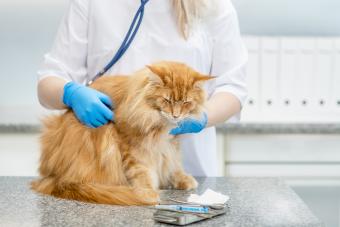
If your cat has a bald spot on their head or is losing the fur around their ears, it may be time to take a closer look at what's going on. There are several reasons for feline hair loss, also known as alopecia. It can be either inherited or acquired.
1. Hereditary Hair Loss
Your cat losing hair on their ears or head may simply be a result of genetics. In cases of hereditary hair loss, there is no underlying cause except for a transfer of genes, so bald patches do not exhibit any irritation and don't seem to bother an affected cat at all. There is no course of treatment to stop the loss or encourage hair to grow again once it has been lost.
According to ProVet Health Care, some breeds of cats prone to hereditary hair loss include:
Acquired Hair Loss
Acquired hair loss is typically a sign of other conditions in play that cause itching. Affected cats will scratch, chew, lick, or rub the itchy patches until the hair is literally rubbed away. If hereditary factors are ruled out, this leaves a host of other possible causes, and some of them are contagious. Just keep in mind that the info presented here is not meant to replace a professional diagnosis from your vet.
2. Ear Mites
Ear mites, scientifically known as Otodectes cynotis, can cause severe itching and results in cat hair loss on the ears and head. These mites are easily transferred to other cats and will sometimes even transfer to people, although they typically cannot survive on humans.
Signs of an ear mite infestation include:
- Head rubbing
- Ear shaking
- Scratching
- Redness
- Hair loss
- Brown, waxy build up in ears
- Foul odor
Ear mites are easily diagnosed using an otoscope. Treatment usually consists of thoroughly but gently cleaning out the ears and applying a vet recommended medication directly into the canals. It is usually necessary to repeat the treatment for up to three weeks to kill all new hatchlings.
3. Fleas

The saliva left behind when a flea bites a cat causes an itchy reaction called flea allergy dermatitis that makes cats scratch like crazy. Although hair loss can occur anywhere on the body, the head, cat's face hair, and the ears are especially vulnerable to hair loss when cats rub themselves against furniture and carpets or scratch at their temples as they try to find some relief.
Fleas are easily detected by their physical presence or by the small droppings they leave in your cat's fur. Infestations can be treated using a number of insecticidal products, including sprays, shampoos, dips, and spot on medications such as Frontline for cats.
4. Ringworm
Contrary to its name, ringworm is not a worm. It's actually an itchy fungal infection that lives in hair follicles and feeds on dead cells. As the fungus populates in the hair shafts, the shafts break off at skin level and leave bald spots. Sometimes crusty patches develop around the ears and other affected areas. Ringworm is very contagious, and it can be diagnosed by culturing the hair for the fungus. There are a number of possible treatments to eliminate the infection.
These include:
- Application of a course of lime sulfur dips
- Administering griseofulvin tablets as recommended by your vet
- Application of a topical ointment such as miconazole
- Repeated antifungal shampoos
- Completely shaving the entire cat
5. Mange
Mange is another type of contagious mite infestation that causes intense itching, especially around the face, ears, and neck. Skin in the affected areas shows a good deal of hair loss, and the skin typically begins to cover over in a kind of grayish-yellow crust that is similar to a bad case of eczema.
Feline mange is divided into two types: notoedric and demodectic. Either type is diagnosed by taking a skin scraping from the affected area and viewing it under magnification for the presence of mites. Depending on the type of mange, it may be necessary to clip away long fur and apply a dip of lime sulfur once a week until subsequent skin scrapings show the mites are gone. Treatments may be repeated as many as six to eight times to cure the infestation.
6. Food Allergies

Food allergies can also produce intense itching and oozing sores, especially around the head, face, ears, and neck. Affected cats quickly begin to lose hair, and chronic ear infections contribute to the problem. Getting a diagnosis of a food allergy requires a series of food trials where your vet will prescribe a restricted diet that will slowly reintroduce foods one at a time until an allergic reaction is noted to a particular item. To learn more about food allergies and many other digestive health concerns for your kitty, consult LoveToKnow's eBook called Happy Tummy Cat, written by a veterinarian to provide quick reference for a multitude of symptoms.
Sometimes more than one food is involved in a reaction, but all problem foods should be permanently eliminated from your cat's diet. Once the offending substances have worked their way out of your cat's system, the sores heal and the hair tends to regrow, although it may be slightly different in color and texture than the original fur.
7. Chronic Stress
Perhaps a less obvious cause, chronic stress does play a role in hair loss. Cats comfort themselves by grooming, and the more stressed they feel, the more they groom. Constant licking and paw washing eventually wear away at the fur, especially in areas with very short fur like the head and ears. This particular condition is known as psychogenic alopecia.
Managing feline stress requires pin-pointing the things that cause the anxiety and eliminating them from your cat's environment as much as possible. Some cats also respond to healthy stimulation, such as a cat tree to exercise on. This relieves boredom and gives your cat something to focus on besides themselves. However, some cats need the help of other solutions like pheromones or anxiety medications.
8. Alopecia Areata
Alopecia areata is not completely understood, but researchers suspect the condition is auto-immune related and may also be complicated by a cat's diet. It appears to cause the most hair loss around the head, neck, and back due to excessive scratching. Vets mainly attempt to treat the condition by testing for food allergies, then eliminating those allergens from the cat's diet.
9. Atopy

Atopy refers to allergies caused by inhaling environmental irritants, such as molds, pollens, dust mites, etc. The allergic reaction produces intense itching that causes a cat to scratch a lot, especially around the head and ears. Treatment includes removing as much of the allergen as possible from the cat's environment or limiting the cat's exposure to the allergen. Antihistamines are sometimes given to the cat to help relieve the itchiness through the worst of the reaction. In some cases, your vet might recommend immunosuppressive medications or allergy shots.
10. Facial Alopecia
Facial alopecia is considered normal hair loss that occurs on the head between the eyes and ears. This type of hair loss appears to be more prominent in cats that have dark, short hair. Since it's considered normal, there's no treatment for it unless you see other signs of a skin condition that might actually be the cause of the hair loss.
11. Sebaceous Adenitis
Sebaceous adenitis is an inflammatory disease of the sebaceous glands. It's quite rare in cats, but it does cause hair loss around the face, head, and ears. There is no cure for this disease, so treatment mainly consists of managing the symptoms by giving the cat anti-inflammatory medications and using anti-scaling shampoo to clean away the crusty lesions that form around the hair follicles.
12. Solar Dermatitis
Also known simply as sunburn, solar dermatitis causes a painful burn followed by flaking and some hair loss. The condition is usually most notable around the ears, but the nose and eyelids are also quite susceptible since they have little to no hair for protection in the first place. Cats who have pink skin and lighter fur are at highest risk. Treatment includes keeping the cat out of the sun and applying an antibiotic ointment to promote healing. Prolonged sun exposure can cause solar dermatitis to develop into squamous cell carcinoma on a cat's ears and face, so it's important to protect your cat from sun damage.
Consult Your Vet
If you notice hair loss on your cat's ears, don't hesitate to take them to your vet. The quicker the cause is diagnosed, the more easily it is treated, and you can prevent the problem from getting completely out of hand. In many cases, the hair on your cat's ears will eventually grow back.







